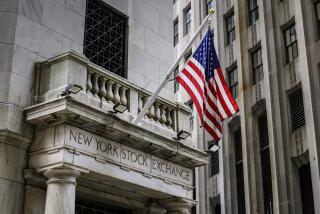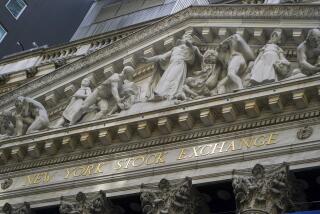CREDIT : Traders, Wary of Stocks, Shift to Bonds; Prices Climb
NEW YORK — Bond prices mostly advanced Thursday, benefiting from a flight by some investors from the jittery stock market.
The Treasury’s closely watched 30-year bond jumped 7/8 point, or $8.75 for every $1,000 in face value. Its yield dropped to 8.83% from 8.90% late Wednesday.
Analysts said a number of investors sold stocks and plowed their funds into the relatively safe haven of the bond market. Wall Street tumbled in selling attributed to misgivings over the recent wave of corporate buyout bids.
The Dow Jones index of 30 industrials dropped 24.35 to 2,140.83.
While Treasuries and other bonds rose briskly, prices of corporate issues fell, reflecting the takeover anxiety.
“People are just scared,” said Marilyn Cohen, president of Capital Insight Inc., a Beverly Hills investment firm. “That terror and fright is really fresh in everyone’s mind,” she said, referring to Wall Street’s memories of last year’s crash.
Bond prices also continued to draw support from Wednesday’s report suggesting that the economy is growing at a slower-than-expected pace.
The Commerce Department reported that the economy grew at a modest 2.2% annual rate from July through September as measured by the gross national product.
Bond investors viewed the GNP report as good news, saying the slower growth should reduce the need for the Federal Reserve to drive interest rates higher to restrain inflation.
Analysts said the positive sentiment carried over into Thursday’s trading, overcoming the negative impact on bond prices of the dollar’s steep decline.
“There’s still some positive feedback from the GNP report,” said John Sebastian, executive vice president of Clayton Brown & Associates, a Chicago investment firm.
In the secondary market for Treasury bonds, prices of short-term government issues rose 3/16 point to point, intermediate maturities advanced 5/16 point to 1/2 point, while long-term issues jumped nearly a full point, according to Telerate Inc., a financial information service.
The movement of a point equals a change of $10 in the price of a bond with a $1,000 face value.
The Shearson Lehman Hutton daily Treasury bond index, which measures price movements on all outstanding Treasury issues with maturities of a year or longer, soared 3.93 to 1,154.62.
Corporate bonds declined, on the other hand, pressured by the anxiety over the recent takeover wave. Moody’s investment grade corporate bond index, which measures price movements on 80 corporate bonds with maturities of five years or longer, slipped 0.17 to 294.79.
Yields on three-month Treasury bills, meanwhile, fell to 7.60% as the discount declined 3 basis points to 7.37%. Yields on six-month bills dipped to 7.86% with the discount falling 4 basis points to 7.47%. Yields on one-year bills declined to 8.05% with the discount losing 5 basis points at 7.50%.
A basis point is one-hundredth of a percentage point. The yield is the annualized return on an investment in a Treasury bill. The discount is the percentage that bills are selling below the face value, which is paid at maturity.
The federal funds rate, the interest on overnight loans between banks, was quoted late in the day at 8.212%, up from 8.25%.
More to Read
Inside the business of entertainment
The Wide Shot brings you news, analysis and insights on everything from streaming wars to production — and what it all means for the future.
You may occasionally receive promotional content from the Los Angeles Times.










